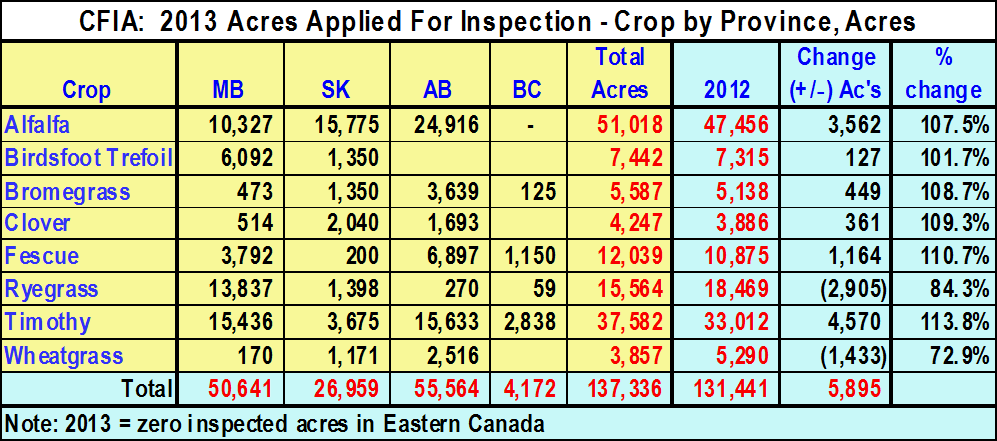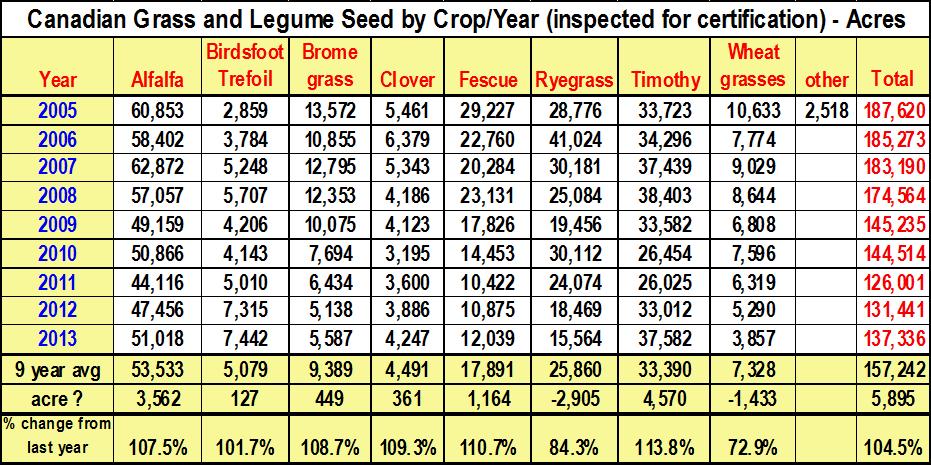| | Overview
For the second consecutive year, Canadian certified seed production of grass and legume seed species increased, although only moderately. 2013 saw 137,336 acres inspected for certification, either into foundation or certified seed stock. The increase in certified acres was led by timothy, which saw inspected acres increase by over 4,500. This was followed by alfalfa, with an increase of 3,500 acres. Fescue acres for certification, primarily
| creeping red fescue, saw inspected acres rise by 1,500. However, inspected ryegrass seed acres, primarily perennial, saw acres decrease by 4,500, while certified wheat grass seed acres fell by 1,500. | |
Table 1: 2013 Inspected Acres, by Crop and Province

Crops:
Overall, alfalfa continues to be the #1 certified crop in Canada, occupying over 51,000 acres in 2013. Alberta, with almost all its certified alfalfa seed acres concentrated in the Brooks AB region, continues to be the #1 producing province. Alberta’s 24,900 acres were over 9,000 more than found in Saskatchewan. Manitoba showed 10,300 acres in 2013. There were no certified growers elsewhere in Canada.
Certified timothy seed acres were grown on 35,500 acres, most of which were proprietary varieties. Over the past 10 years, certified seed production has held steady between 26,000 and 38,000 acres. Timothy continues to be a high demand crop around the world and is used in many mixtures, as well as solid seeding.
| With very short supplies and continued good demand, 2013 finally saw certified bromegrass seed acres increase, but only by 400+ acres. Both certified and common smooth bromegrass seed supplies are very short at present. | |
Although there were 1,200 more acres of fescue under certification in 2013, overall acres (certified and common) of creeping red fescue continue to fall. The additional certified acres in 2013 are quite possibly certified fields that were only harvested as common seed the past 2 years, with growers applying again for certification this year (a producer can apply for certification for 5 year’s following the seeding year)
Certified ryegrass seed acres fell for the 3rd consecutive year, with 2013 showing 15,500 acres inspected. Poor establishment and fewer contracts of perennial ryegrass have contributed to this situation. Manitoba continues to be the major producer, and at one time had over 31,000 acres herself.
| Certified clover seed production, mainly red clover, alsike clover and sweet clover, saw inspected acres rise slightly, 360 acres. Manitoba’s acres fell to close to only 500. Alberta acreage fell as well, as only 1,700 acres were inspected, down from 1,900 the previous year. However, Saskatchewan saw acres increase by over 1,000, with just over 2,000 acres inspected in 2013. | |
Strong pricing for birds-foot trefoil resulted in certified acres continuing to rise, with another 100+ acres inspected in 2013 (7,440 total). The past two years has seen over 7,000 certified acres in production, well above long term average acres.
Canadian wheatgrass acres fell by over 1,400 acres in 2013 (a 27% drop). This was despite strong prices received the past two years for crested wheatgrass and other wheatgrass species.
Historical Acres:
Table 2: Certified Canadian Grass & Legume Seed Acres, by Crop (2005 to 2013)

Additional Comments:
Manitoba and Alberta continue to be the heartland of certified grass and legume seed production, with both provinces growing over 50,000 acres. Certified seed production continues to be affected by slowed down usage in both the livestock industry and turf grass seed industry. The USA will have to re-seed many hay fields and pastures following their devastating 2012 drought, but more drought tolerant species may be used, as the southern states were most affected.
| With Canadian farmers still experiencing good returns from traditional annual crops (wheat, canola, etc.), the production of grass and legume seed crops has continued to fall. Growers also do not want to switch into a crop in which they may also lose a year of production. (e.g.: creeping red fescue) | |
The economic turmoil, which accompanied the 2008 world financial crisis and subsequent depressed housing market in North America, can still be seen in the overall turf seed marketplace. The resulting economic crunch being encountered by the various levels of government in the USA has seen a cutback in spending, which continues to affect the turf grass seed industry. Production acres (common and certified) of both creeping red fescue and the ryegrasses continue to fall. And, as the economic crisis is a world-wide phenomenon, and with the EU only accepting certified seed stock, Canadian certified seed movement to Europe is also affected.
| With the decline in Canadian livestock numbers, and subsequent loss of hay and pasture acres, the need for forage grasses and legumes declined as well. With the livestock sector now slowly recovering, the need for grass and legume seed will rise, but not in the foreseeable future. | |
Prepared by David Wong, Market Specialist, Alberta Agriculture & Rural Development, Ag-Info Centre (310-3276)
E-mail: david.k.wong@gov.ab.ca
|
|